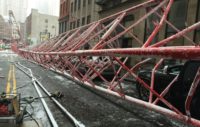Did the crew working on the crane that collapsed in New York City Feb. 5 act soon enough and have enough time to secure the equipment before strong winds blew?
In response to last week’s crawler crane collapse in lower Manhattan that killed a pedestrian, New York City Mayor Bill de Blasio announced new safety regulations Feb. 8 lowering the maximum wind speed at which the cranes must stop operating, to a sustained 20 mph or gusts of 30 mph. Previously, crane operation could continue until steady wind speeds hit 30 mph or gusts reached 40 mph.
With the focus on wind, one crane expert suggested that securing a crane when winds are already troublesome could open the door to more trouble.
Another expert suggested that a crane operator could easily make a mistake while bringing the crane jib and boom down, properly balanced, in what is called a jack-knifing maneuver.
"The main boom was not at the correct angle," speculated one crane expert after reviewing a video of the accident. "The main boom was too low to jack-knife."
"It's simple, but complex, a tricky procedure with that amount of boom," the expert claims. "Why was this not done the night before?"
As part of its crane safety procedures, New York City's Dept. of Buildings sends out emails to crane operators about potentially troublesome weather the following day. It isn't clear what if any information the city provided the crane operators.
Tricky Transitions in Securing Crane
Another expert, far from New York City, confirmed the difficulties involved in securing a crane once winds have picked up speed.
Aviad Shapira, professor of construction engineering and management at the Technion—Israel Institute of Technology in Haifa , says securing a crane under windy conditions may provoke trouble during the transition.
At the time of the collapse early Feb. 5, the crane’s operator was lowering the 565-ft-long boom and jib because of high winds. As the boom and jib descended, they seemed to pick up speed until they struck buildings and cars on Worth St., a narrow, uncrowded side street.
The falling boom struck David Wichs, 38, as he walked down the street, killing him instantly. Three others were injured, two seriously. Thomas O’Brien, 73, suffered a head injury as the crash trapped him in his car, while Dawn Kojima, 45, was struck in the head by falling debris on her way to work.
The crane was working on the renovation of 60 Hudson St. Galasso Rigging and Trucking, a New York City-based company with more than 60 years of experience, ran the crane.
Another longtime New York City-area company, Bay Crane, owned the equipment and employed operating engineers' union member Kevin Reilly, 56, as the operator. He apparently was uninjured.
Theories Abound
All cranes must be used within the manufacturer's or designer's rated loads for the conditions of use.
Soon after the accident, some suggested a brake failure or improper sequence in lowering the jib and boom had led to the tragedy. A photo of the crane’s headache ball—a metal sphere that is part of the crane's hook—that showed it apparently crashed into an office near the site, triggered more speculation.
While wind speed is a factor, crane experts say, several factors could have contributed to the accident: weather, including wind, human error, management error or technical failure.
Shapira said a key is whether due precautions were taken during the snow and wind conditions.
“The question is, have due precautions been taken? If not, it is a typical management issue, combined with an environmental factor," he said. "If the snow was wet, it added significantly to the weight of the boom." He speculates also whether the issue of the extra weight was ignored, which could be "another management issue.”
Wind speed is greater the higher you go above grade, notes Bradley Closson, president at CRAFT Forensic Services. “This was a tall boom so the wind at the tip was probably more than what has been reported. Additionally, "buildings create a 'venturi effect' so that the wind funneling between the buildings can be much faster than that felt before entering that funnel,” he says.
The Feb. 5 accident occurred on the second attempt to secure the crane, after the first had been halted following gusts as high as 40 mph.
But lowering a crane boom and jib in high winds could bring on other possible problems.
“What might look as a necessary action to be taken in the face of the severe storm, namely, lowering the boom, could actually – under certain circumstances – work the other way around, worsening the situation,” says Shapira.
“Cranes are well designed to be in their "natural' state" of lifting and moving loads," says Shapira. "When you set up a crane or take it down, you put the crane in an 'unnatural' state. If during that time other factors surface such as wind and accumulating wet snow, the crane might be in jeopardy and the situation more hazardous."
The crane expert adds that in this case the crane was being secured under harsh conditions, "which also gives room [for] plenty of human errors.”
CORRECTION (2/10/16 11:16 A.M.): An earlier version of this story mentioned Gilbane Building Co. in error. Gilbane has no involvement in current 60 Hudson Street work. Project owner DataGryd announced last October that Nova Mission Critical is executing the buildout of the current phase of its 240,000-square-foot urban data center. A spokesman for that firm confirms it is working on site and that the accident is under investigation.



Post a comment to this article
Report Abusive Comment